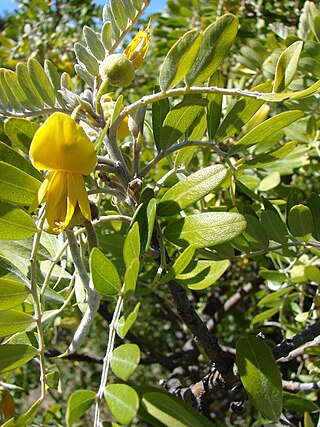
Sophora is a genus of about 45 species of small trees and shrubs in the pea family Fabaceae. The species have a pantropical distribution. The generic name is derived from sophera, an Arabic name for a pea-flowered tree.

Carmichaelia is a genus of 24 plant species belonging to Fabaceae, the legume family. All but one species are native to New Zealand; the exception, Carmichaelia exsul, is native to Lord Howe Island and presumably dispersed there from New Zealand.

Clianthus, commonly known as kakabeak, is a genus of flowering plants in the legume family Fabaceae, comprising two species of shrubs endemic to the North Island of New Zealand. They have striking clusters of red flowers which resemble the beak of the kākā, a New Zealand parrot. The plants are also known as parrot's beak, parrot's bill and lobster claw – all references to the distinctive flowers. There is also a variety with white to creamy coloured flowers called: "Albus," and a variety with rosy pink flowers called: "Roseus."

Clianthus puniceus, common name kaka beak, is a species of flowering plant in the genus Clianthus of the legume family Fabaceae, native to New Zealand's North Island.

Carmichaelia carmichaeliae is a species of plant in the family Fabaceae. It is found only in South Island of New Zealand. It is classified as having the "Nationally Critical" conservation status under the New Zealand Threat Classification System.

Galegeae is a tribe in the flowering plant family Fabaceae, subfamily Faboideae. The tribe is found mostly in the northern hemisphere, but can also be found in Australia, Africa, and South America. Recent molecular phylogenetic work has determined that tribe Galegeae is paraphyletic, and that its members are scattered throughout the IR-lacking clade.

Melicytus is a genus of flowering plants in the family Violaceae. Hymenanthera is a synonym. It includes 19 species native to Australia, New Zealand, and the southwestern Pacific.

Pleurophyllum speciosum, also known as the giant emperor daisy or Campbell Island daisy, is a megaherb native to the Auckland and Campbell Islands of New Zealand. A false colour image is depicted on the lower left corner on the reverse of the current five dollar New Zealand banknote. The Campbell Island daisy was first described by Joseph Dalton Hooker in Flora Antarctica of 1844, after he had collected it during the Ross expedition.

Sporadanthus ferrugineus, the bamboo rush or giant wire rush, is a restiad plant endemic to the northern North Island of New Zealand.

Aceria clianthi is a species of mite belonging to the family Eriophyidae. It is found only in New Zealand. It is notable for being host specific to threatened plants of the genus Clianthus. It is classified by Buckley et al. as "nationally critical" under the New Zealand Threat Classification System. They stated "Aceria clianthi (Eriophyidae), has been recorded only from kakabeak in cultivation and once on Lotus cornalatus [Lotus corniculatus] (Fabaceae), an introduced plant growing near kakabeak. It is given the same threat classification as kakabeak ." Heenan had earlier stated that "the two species [of Clianthus] are considered to be threatened, with C. maximus having a rank of vulnerable, whereas C. puniceus is critically endangered", but the conservation status of C. maximus was subsequently found to be more serious. These threat classifications for Clianthus apply to plants in the wild, but the species are widely cultivated. Aceria clianthi occurs on both plants in the wild and in cultivation.
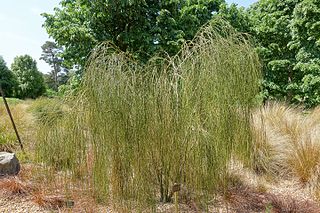
Carmichaelia stevensonii, the cord broom or weeping broom, is a species of plant in the family Fabaceae. It is found only in the north east of the South Island of New Zealand. It is threatened by habitat loss.

Carmichaelia muritai, common name coastal tree broom, is a species of plant in the family Fabaceae. It is found only in the South Island of New Zealand.
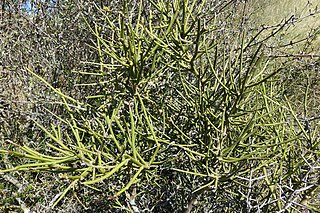
Carmichaelia petriei is a species of New Zealand broom in the genus Carmichaelia. It is endemic to New Zealand. C. petrieis is possibly a host plant for the critically endangered fungus weevil Cerius otagensis.
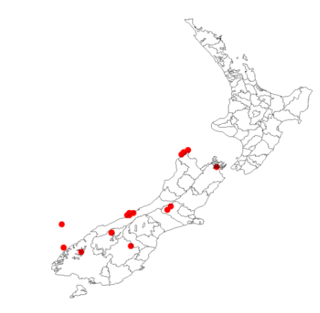
Carmichaelia juncea, the braided riverbed broom, is a species of New Zealand broom, a prostrate shrub in the family Fabaceae that is endemic to New Zealand. It is extinct over much of its former range, including the North Island.

Carmichaelia curta is a species of plant in the family Fabaceae. It is found in New Zealand. It is classified as having the "Nationally Critical" conservation status under the New Zealand Threat Classification System.
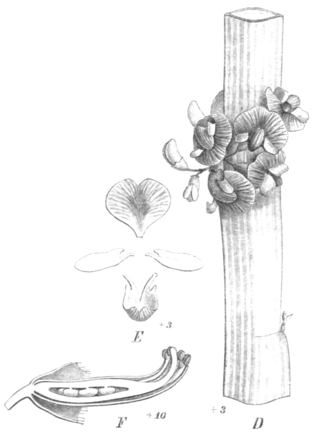
Carmichaelia australis, commonly known as the New Zealand common broom or mākaka, is a shrub of the Fabaceae family. It is native to New Zealand and found in both the North and South Islands.
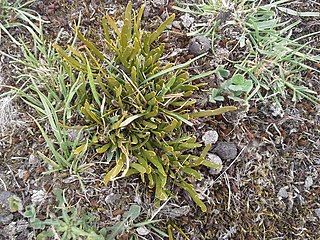
Carmichaelia corrugata is a species of plant in the family Fabaceae. It is found only on the South Island of New Zealand.

Actinotus novae-zelandiae is a plant in the Apiaceae family, native to the South Island of New Zealand.

Dracophyllum menziesii, commonly known as pineapple scrub, is a species of shrub endemic to the South and Stewart Islands of New Zealand. In the heath family Ericaceae, it inhabits mountain slopes and cliffs from sea level up to 1,500 m (4,921 ft) and reaches a height of 0.5–1 m (1.6–3.3 ft). A 2017 assessment using the New Zealand Threat Classification System classified it as "Not Threatened", giving it an estimated population upwards of 100,000.

Plantago novae-zelandiae is a species of flowering plant in the family Plantaginaceae that is endemic to New Zealand. Lucy Moore described P. novae-zelandiae in 1961. Plants of this species of plantain are perennial with a rosette habit, leaves widest above the middle, up to 4 ellipsoid seeds per capsule, glabrous bracts and sepals, and punctate leaves. It is listed as Not Threatened.





















